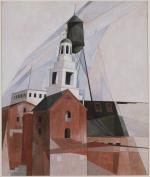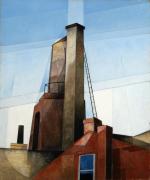![header=[Marker Text] body=[Born in Lancaster, Nov. 8, 1883. Demuth achieved international fame for his precise, modernist paintings including "My Egypt" and "I Saw the Figure 5 in Gold." He traveled in the U.S. and abroad but resided after 1889 in this house. Here he died in 1935.] sign](http://explorepahistory.com/kora/files/1/10/1-A-3AC-139-ExplorePAHistory-a0m6e0-a_450.jpg)
Mouse over for marker text
Name:
Charles Demuth
Region:
Hershey/Gettysburg/Dutch Country Region
County:
Lancaster
Marker Location:
118 E. King St., Lancaster
Dedication Date:
November 8, 1983
Behind the Marker
The first American artist to embrace cubism, Charles Demuth (1883-1935) was able comfortably to pursue his career as a painter thanks to his family's income from Demuth's Tobacco Shop in Lancaster, Pennsylvania. Founded in 1770, it is today the oldest functioning tobacco store in the United States. The artist's home, next door at 120 E. King Street, is now the site of the Charles Demuth Foundation, which also serves as a museum of his works.
Lame, diabetic, and homosexual, Demuth studied at Drexel University and the Pennsylvania Academy of Fine Arts with Thomas Anschutz. He visited Europe three times between 1907 and 1921, spending most of his time in Paris and meeting great modern artists such as Picasso, and writers including Gertrude Stein. While there, he illustrated books by Henry James, Emile Zola, and Edgar Allen Poe, among others.
Pennsylvania Academy of Fine Arts with Thomas Anschutz. He visited Europe three times between 1907 and 1921, spending most of his time in Paris and meeting great modern artists such as Picasso, and writers including Gertrude Stein. While there, he illustrated books by Henry James, Emile Zola, and Edgar Allen Poe, among others.
Before the 1920s, when not in Europe, he lived most of the time in Provincetown and New York, where his watercolors chronicled the bohemian, avant-garde existence he followed. Like the French painter Toulouse-Lautrec, also a cripple, Demuth was attracted to cafes, the circus, and the theater, and painted many scenes of the entertainment world. In New York, he exhibited at Alfred Stieglitz's 291 Gallery.
Like his fellow modernist and friend Marcel Duchamp - the wing devoted to Duchamp is one of the glories of the Philadelphia Museum of Art - Demuth worked in several styles. His water colors were mostly still lifes and sketches of people in a fairly traditional impressionist style. A series of posters honoring other artists and writers - which he left to his friend Georgia O'Keefe - reflect his wit, the appreciation of his contemporaries, and a possible tribute to Toulouse-Lautrec's contribution to that genre. Most famous of these is the poster for writer William Carlos Williams, a close friend, The Figure Five in Gold (1928). The most famous of Demuth's works, this cubist abstract he based upon a poem, "The Great Figure," that Williams wrote about a New York City fire engine.
It is unclear whether an injury or disease damaged Demuth's hip as a child, but by 1921 he was bedridden and forced to retire to Lancaster, where his mother Augusta tenderly cared for him in a second-floor studio in the family home overlooking her garden, another subject of his works. Confined to a provincial environment he disliked, Demuth then produced his best known series of works, his industrial landscapes. The most famous is My Egypt (1927), in which his stark depiction of a grain elevator in Lancaster evokes the land of slavery out of which the ancient Hebrews escaped. It also links the elevators with death and the Egyptian tombs being excavated in the 1920s, an era when Egyptian style architecture (see, for example, the Barnes Foundation in Lower Merion) was in vogue. Another well-known painting of two factory smokestacks he whimsically titled Aucassin and Nicolette (1921) after famous medieval lovers.
Yet a third theme of Demuth's work was homosexuality: he painted many scenes of same-sex lovers, most notably his Turkish Bath with Self-Portrait (1918) in which he appears as a nude figure with two others. Many of his works on this theme only became known in the 1980s as the gay rights movement flourished. When Demuth died, he left his Lancaster partner Robert Locher his watercolors and works on homosexual themes.
Open to the public, the Demuth Museum in Lancaster maintains Charles Demuth's home as a museum and art gallery, and preserves the adjacent eighteenth century buildings that belonged to the Demuth family for five generations.
Lame, diabetic, and homosexual, Demuth studied at Drexel University and the
Before the 1920s, when not in Europe, he lived most of the time in Provincetown and New York, where his watercolors chronicled the bohemian, avant-garde existence he followed. Like the French painter Toulouse-Lautrec, also a cripple, Demuth was attracted to cafes, the circus, and the theater, and painted many scenes of the entertainment world. In New York, he exhibited at Alfred Stieglitz's 291 Gallery.
Like his fellow modernist and friend Marcel Duchamp - the wing devoted to Duchamp is one of the glories of the Philadelphia Museum of Art - Demuth worked in several styles. His water colors were mostly still lifes and sketches of people in a fairly traditional impressionist style. A series of posters honoring other artists and writers - which he left to his friend Georgia O'Keefe - reflect his wit, the appreciation of his contemporaries, and a possible tribute to Toulouse-Lautrec's contribution to that genre. Most famous of these is the poster for writer William Carlos Williams, a close friend, The Figure Five in Gold (1928). The most famous of Demuth's works, this cubist abstract he based upon a poem, "The Great Figure," that Williams wrote about a New York City fire engine.
"Among the rain
and lights
I saw the figure 5
in gold
on a red
firetruck
moving
tense
unheeded
to gong clangs
siren howls
and wheels rumbling
through the dark city."
It is unclear whether an injury or disease damaged Demuth's hip as a child, but by 1921 he was bedridden and forced to retire to Lancaster, where his mother Augusta tenderly cared for him in a second-floor studio in the family home overlooking her garden, another subject of his works. Confined to a provincial environment he disliked, Demuth then produced his best known series of works, his industrial landscapes. The most famous is My Egypt (1927), in which his stark depiction of a grain elevator in Lancaster evokes the land of slavery out of which the ancient Hebrews escaped. It also links the elevators with death and the Egyptian tombs being excavated in the 1920s, an era when Egyptian style architecture (see, for example, the Barnes Foundation in Lower Merion) was in vogue. Another well-known painting of two factory smokestacks he whimsically titled Aucassin and Nicolette (1921) after famous medieval lovers.
Yet a third theme of Demuth's work was homosexuality: he painted many scenes of same-sex lovers, most notably his Turkish Bath with Self-Portrait (1918) in which he appears as a nude figure with two others. Many of his works on this theme only became known in the 1980s as the gay rights movement flourished. When Demuth died, he left his Lancaster partner Robert Locher his watercolors and works on homosexual themes.
Open to the public, the Demuth Museum in Lancaster maintains Charles Demuth's home as a museum and art gallery, and preserves the adjacent eighteenth century buildings that belonged to the Demuth family for five generations.






